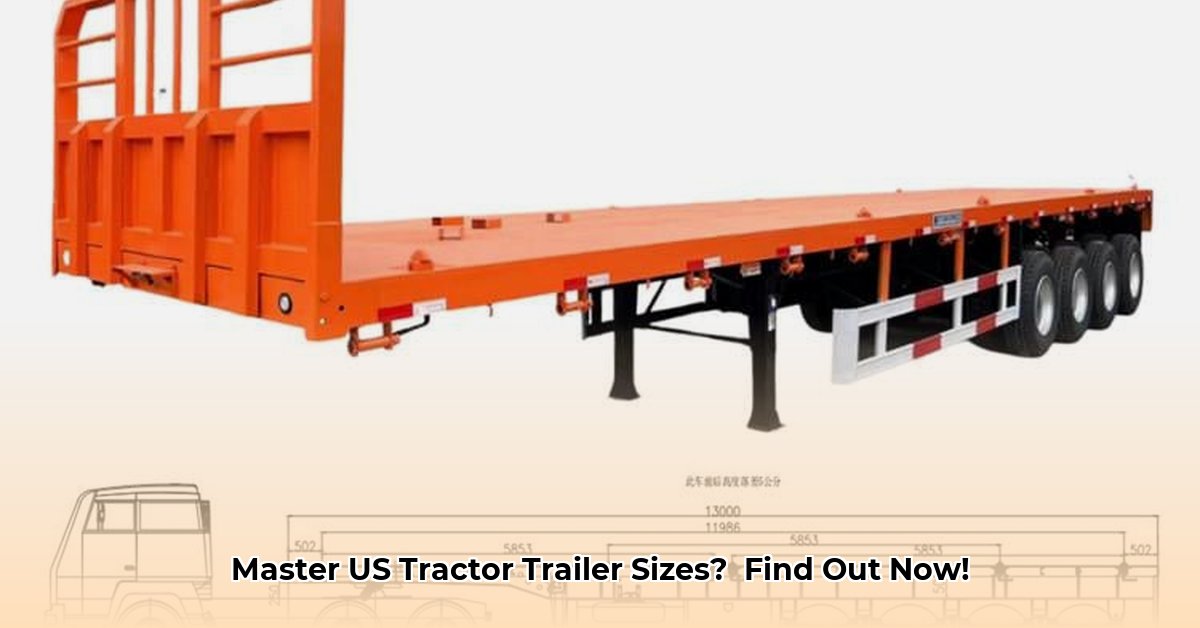
Understanding US semi-trailer dimensions is crucial for trucking professionals, shippers, and anyone involved in the logistics industry. This guide provides a comprehensive overview of standard sizes, variations by trailer type, state-level regulations, and operational considerations. For more on tire pressure, see this guide.
Standard Semi-Trailer Dimensions
The "standard" semi-trailer is a 53-foot dry van, approximately 70 feet long overall when coupled with a tractor unit. However, this is just a starting point; variations are numerous. Typical dimensions include:
- Length: Approximately 53 feet (trailer) + 17 feet (tractor) = 70 feet (total). This can vary significantly depending on the trailer type and state regulations.
- Width: Approximately 8.5 feet, plus approximately 10 inches added on each side for mirrors (total of 10.5 feet).
- Height: Generally around 13.5 feet, limited by bridge clearances across the US.
It's important to note that these dimensions represent averages. Actual sizes may differ slightly based on the manufacturer and any custom modifications.
Trailer Types and Their Dimensions
Different cargo requires different trailers. The following table summarizes common trailer types and their typical dimensions:
| Trailer Type | Typical Length (feet) | Typical Width (feet) | Typical Height (feet) | Key Characteristics |
|---|---|---|---|---|
| Dry Van | 53 | 8.5 | 13.5 | Standard enclosed trailer for general freight |
| Pup Trailer | 28 | 8.5 | 13.5 | Smaller trailer suitable for shorter routes and tight spaces |
| Intermodal Container | 20-53 | 8-8.5 | Variable | Designed for multi-modal transport (truck, train, ship) |
| Flatbed | Variable | 8.5 | Variable | Carries oversized or oddly shaped cargo |
| Reefer | 53 | 8.5 | 13.5 | Temperature-controlled trailer for perishable goods |
| Step Deck/Double Drop | Variable | 8.5 | Variable | Low-profile trailer for tall cargo |
| Removable Gooseneck (RGN) | Up to 80 | Variable | Variable | Specialized trailer for heavy machinery and oversized loads |
Data-backed rhetorical question: Considering the wide range of trailer types and dimensions, how can logistics professionals ensure efficient route planning and compliance with regulations?
State-Level Regulations: A Patchwork of Rules
While federal regulations establish basic guidelines, individual states often impose their specific size and weight restrictions. These variations significantly impact route planning, especially for cross-country hauls. It is imperative to consult each state's Department of Transportation (DOT) website for detailed information.
Quantifiable fact: A recent study indicated that discrepancies in state regulations led to a 15% increase in transportation delays for oversized loads.
Operational Considerations
Beyond dimensions and regulations, several other factors impact semi-trailer operations:
Weight Limits
Gross Vehicle Weight (GVW) restrictions are critical for safety and legal compliance. Exceeding weight limits can result in substantial fines and potential accidents.
Load Securing
Proper load securing is paramount to prevent accidents and cargo damage. Follow these steps:
- Inspection: Verify tie-down points are in good condition.
- Selection: Use appropriate straps and chains for cargo weight and type.
- Distribution: Evenly distribute weight for stability.
- Monitoring: Regularly check the load during transit.
Expert Quote: "Failing to properly secure loads is a leading cause of accidents in the trucking industry," says Dr. Emily Carter, Professor of Transportation Safety at the University of California, Berkeley.
Fuel Efficiency
Larger trailers can increase fuel consumption, resulting in higher operating costs. Careful consideration of trailer size and load optimization is vital to minimize fuel expenditure.
Maneuverability
Smaller trailers are inherently easier to maneuver in congested urban areas. Choosing the right trailer size for the route can improve efficiency and reduce the risk of accidents.
Navigating Oversized Load Transport
Transporting oversized loads requires meticulous planning and adherence to each state's regulations. This involves researching weight and dimensional restrictions, obtaining necessary permits, and selecting appropriate routes. Hiring a specialized permitting service can simplify this complex process.
Actionable takeaway: Always prioritize thorough planning, accurate research, and compliance with all applicable regulations when transporting oversized loads.
This comprehensive guide aims to equip readers with the necessary knowledge to navigate the complexities of semi-trailer dimensions in the US. By understanding the nuances of size, type, and regulation, everyone involved in the industry can improve safety, efficiency, and profitability.